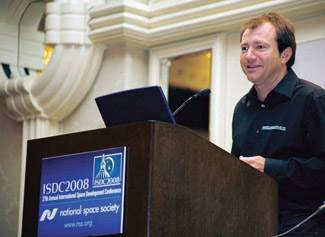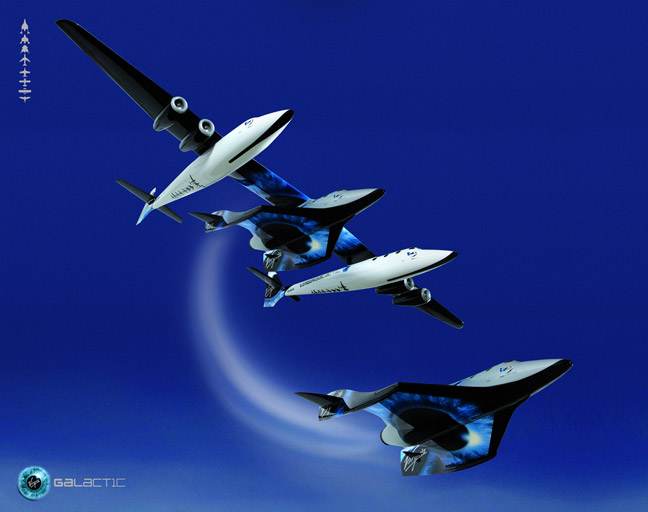From Ad Astra, Volume 20 Number 3, Fall 2008
A new NSS program will bring space to the people, and send one person into space
By Katie Bailey
At the 2008 International Space Development Conference (ISDC) in May, NSS and Virgin Galactic announced the launch of Space Ambassadors—a new program that will encourage space enthusiasts to share their passion with local communities and award one person a suborbital spaceflight aboard Virgin Galactic’s SpaceShipTwo.
The program constitutes a milestone for the Society: After decades of celebrating space and those who explore it, we finally have the opportunity to send one of our own members into space. If you are interested, you can sign up online via the Space Ambassadors page to receive project updates. As of this writing, nearly 3,000 people have expressed their intent to join the program. The official registration process is expected to be posted in fall 2008.
George Whitesides, NSS executive director, said, “The Space Ambassadors program will communicate the benefits of space to the world, and open the opportunity for spaceflight to one deserving person.”
Space Ambassadors will be trained to deliver a new presentation designed to educate and inspire the public about the benefits of space exploration and research. Using video and animation, the presentation will serve as an updated version of the successful NSS slide show program. Ambassadors will make presentations to a variety of local groups, such as schools, Rotary Clubs, and churches.
Ambassadors will be able to record their community outreach over the next year on a special Web site. A selection process will then be conducted to choose one deserving Space Ambassador who, as part of their job duties, will fly to space onboard Virgin Galactic’s SpaceShipTwo. Currently, that flight is expected to be scheduled during the first 18 months of Virgin’s commercial operations. That Space Ambassador will then be expected to conduct further outreach based on their space experience.
At the ISDC announcement, Will Whitehorn, President of Virgin Galactic, said, “We are very excited by the prospect of supporting the NSS Space Ambassadors Program because we believe wholeheartedly in its aim of communicating a passion both for space exploration and for research into the huge benefits of using space to help solve practical problems here on Earth.”

Whitehorn continued, “We hope that a seat on a Virgin Galactic flight will provide tangible encouragement for a generation of new space ambassadors to come forward and inspire the astronauts, space scientists, and extraterrestrial entrepreneurs of the future.”
The Space Ambassadors program’s goals reflect the NSS mission, focusing on education and outreach by spreading the word of the benefits of space exploration and research. The program will allow people “to experience the wonder, the beauty, and the impact of space firsthand,” Whitesides said. “Space Ambassadors will serve as an envoy of humankind to the final frontier. [They can] bring that experience back, connect it with people’s everyday lives, and remind us all that space is a critical part of the solution to many of the problems we are facing today.”
One of the main objectives of the program is to encourage students to pursue careers in science, engineering, and mathematics. In order to continue a presence in space, organizations— including NASA—need future engineers and scientists to conduct research and develop new technology. These industries must continue to grow, especially in today’s world of quickly advancing technologies.
While the program will work to inspire young people to study math and science, it will also draw support for future space endeavors. Without support from citizens and their governments, there will not be the necessary funding or regulations to further space exploration and research. “NSS and Virgin Galactic are both excited about the potential ways in which space can really address some of the deepest and most serious issues facing humanity,” said Whitesides. “We think that this is going to be a tremendous program in which to capture the interest and passion of people for space and direct it toward communicating that passion to the public.”
Whitehorn is optimistic about public interest in space: “people are beginning to get the fact that we need to be in space again.”
Space Ambassadors is designed to reinspire enthusiasm in space development by showing everyday communities the benefits that they have gained from spacebased technology and the improvements to their lives as a result of space exploration research. It will also underscore the importance of continuing research. Whitesides remarked, “It is time to connect what we are doing in space to the economic, political, social, and environmental challenges of our time.”
Not only will the program reveal the benefits of space exploration and research to the public, it will also promote the next step in commercial flying: suborbital space flights. The commercial suborbital spaceflight business is a developing industry in which Virgin Galactic has established itself as a leader. On July 28, 2008 Virgin Galactic unveiled WhiteKnightTwo, the jet-powered carrier aircraft that will carry SpaceShipTwo into suborbital space.
SpaceShipTwo will be capable of carrying six “space tourists” at a time. Initial seats onboard currently cost $200,000. Thus, the opportunity to secure a seat on Virgin Galactic’s SpaceShipTwo is an experience many people dream of—and one that is well worth the duties of being a Space Ambassador. Whitehorn explained, “Since I was a kid I have always wanted to go to space.” This dream has fueled him to make trips to space a possibility not only for himself, but for others as well.








